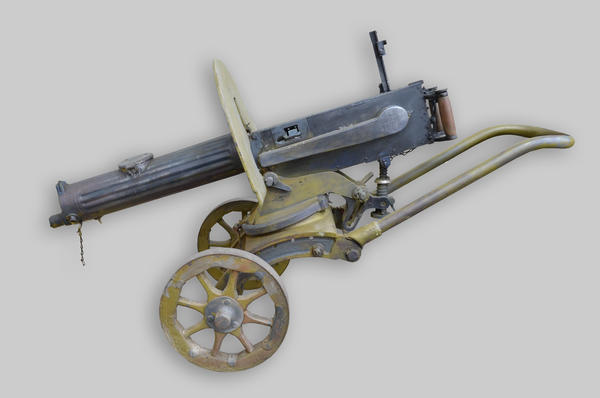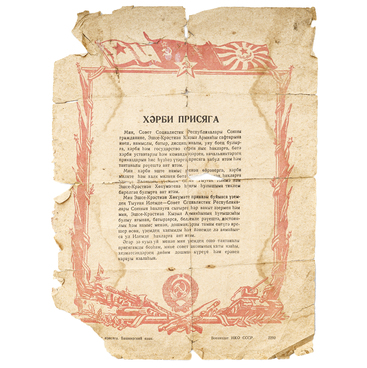The invention of the Maxim mounted machine gun played a most important role in the world arms industry. Before that mitrailleuses (a sort of a volley gun) were in use. The bolt was locked and the firing pin was cocked manually by rotating the handle. It quickly made the fighting men tired and degraded the effectiveness of fire. The appearance of a mounted machine gun heralded an era of arms referred to as the ‘hell’s mower’.
The inventor is the American engineer Hiram Stevens Maxim. In 1880 he presented the machine gun to his compatriots and later to the Brits. To give a graphic example he immersed the machine gun into the water, retrieved it and fired without preparation. He released in a row up to 15 thousand rounds demonstrating an indestructible capability of his weapon. But the Americans and the English were not impressed. Military commanders did not see the need for such rate of fire and the use of a tremendous quantity of ammunition. Only the banker Nathaniel Rothschild believed in the potential of the invention and began to sponsor its promotion.
Russia, on the contrary, was interested in the Maxim back in the times of Alexander III. During the Russo-Japanese war of 1904-1905 the employment of this weapon was on a massive scale. At that time there was one mounted machine gun per 5,000 soldiers. But a big weight seriously complicated its employment under the conditions that required fast movement. On heavy mounts its weight was almost 250 kg. For the Russian armed forces the Maxim was produced under a license of the British company. It was a weapon of the wide-spread rifle caliber of 7.62 mm.
The Maxim mounted machine gun of 1910 is its first modernization. It was carried out by the gunsmith I.A.Sudakov, colonel P.P.Tretyakov and foreman I.A.Pastukhov. Using the facilities of the Tula Arms Plant they replaced bronze parts with steel ones and reduced the total weight of the weapon. In full gear its weight became less than 70 kg. The Russian officer Sokolov fitted it with a light-weight mount and a metal shield. The first trials were held in June 1909. The version of the Tula gunsmiths became the main competitor of the Vickers machine gun, an English counterpart of the Maxim.
In Soviet literature one can read a statement that Russian technicians created a new weapon, but this is not quite so. Modernization noticeably improved the weight specifications and simplified the use of the machine gun in the field conditions. However, series models were still based on the one and the same mounted Maxim. The Soviet republic did not produce new weapons. For this reason a mobile mount of the Tula gunsmiths became the main weapon of this type in the Red Army. By the 1920-s the plant had already manufactured and repaired as many as several thousand machine guns.
Another modernization was carried out in 1930. The casing’s stiffness was enhanced. A 2 x optical sight was added, while the organic one was adapted for firing various rounds. During the severe winter of 1939-1940 the machine gun began to lose its effectiveness. The legendary Maxim was found obsolete and was replaced on the battlefield with the Degtyaryov DS-39 machine gun. But the Tula gunsmiths still got back to it in 1941 to modify it for the last time.
The inventor is the American engineer Hiram Stevens Maxim. In 1880 he presented the machine gun to his compatriots and later to the Brits. To give a graphic example he immersed the machine gun into the water, retrieved it and fired without preparation. He released in a row up to 15 thousand rounds demonstrating an indestructible capability of his weapon. But the Americans and the English were not impressed. Military commanders did not see the need for such rate of fire and the use of a tremendous quantity of ammunition. Only the banker Nathaniel Rothschild believed in the potential of the invention and began to sponsor its promotion.
Russia, on the contrary, was interested in the Maxim back in the times of Alexander III. During the Russo-Japanese war of 1904-1905 the employment of this weapon was on a massive scale. At that time there was one mounted machine gun per 5,000 soldiers. But a big weight seriously complicated its employment under the conditions that required fast movement. On heavy mounts its weight was almost 250 kg. For the Russian armed forces the Maxim was produced under a license of the British company. It was a weapon of the wide-spread rifle caliber of 7.62 mm.
The Maxim mounted machine gun of 1910 is its first modernization. It was carried out by the gunsmith I.A.Sudakov, colonel P.P.Tretyakov and foreman I.A.Pastukhov. Using the facilities of the Tula Arms Plant they replaced bronze parts with steel ones and reduced the total weight of the weapon. In full gear its weight became less than 70 kg. The Russian officer Sokolov fitted it with a light-weight mount and a metal shield. The first trials were held in June 1909. The version of the Tula gunsmiths became the main competitor of the Vickers machine gun, an English counterpart of the Maxim.
In Soviet literature one can read a statement that Russian technicians created a new weapon, but this is not quite so. Modernization noticeably improved the weight specifications and simplified the use of the machine gun in the field conditions. However, series models were still based on the one and the same mounted Maxim. The Soviet republic did not produce new weapons. For this reason a mobile mount of the Tula gunsmiths became the main weapon of this type in the Red Army. By the 1920-s the plant had already manufactured and repaired as many as several thousand machine guns.
Another modernization was carried out in 1930. The casing’s stiffness was enhanced. A 2 x optical sight was added, while the organic one was adapted for firing various rounds. During the severe winter of 1939-1940 the machine gun began to lose its effectiveness. The legendary Maxim was found obsolete and was replaced on the battlefield with the Degtyaryov DS-39 machine gun. But the Tula gunsmiths still got back to it in 1941 to modify it for the last time.



